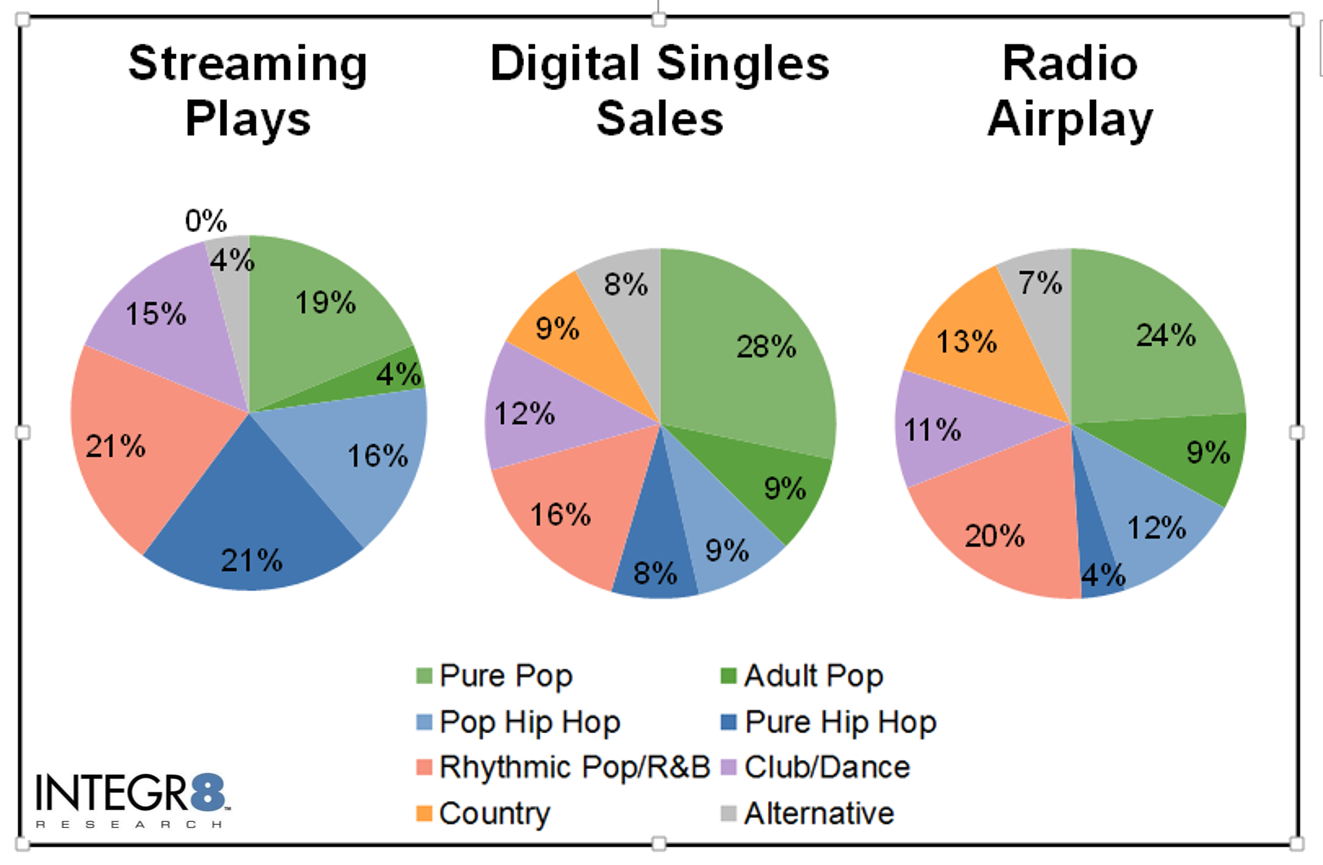We’ve recently been examining whether you should rely more heavily on streaming usage or sales data when picking new music for your station. Our first post suggested that both sales and streaming data remain relevant to radio, at least for now. Our second post showed how streaming users are typically younger than music purchasers.
In this post, we’ll examine which styles of songs are most popular among streaming users, music purchasers, and radio listeners. For this analysis, we examined Billboard’s 2016 year end charts to find out:
- Which songs listeners played most on the Streaming Songs chart on services such as Spotify and YouTube
- Which songs listeners paid to download most often on the Digital Songs chart on services such as iTunes
- Which songs listeners heard most on the Radio Songs chart
We then had our team of music experts code each song’s music style. Here’s what our analyses revealed:
Hip Hop is huge on streaming
Listeners stream Hip Hop significantly more on streaming services than they buy it or hear it on the radio. Thirty-seven percent (37%) of the most streamed songs were Hip Hop, compared to 17% of the biggest paid digital download songs and 16% of the songs played most on radio.
The most striking difference comes from the appeal of Pure Hip Hop compared to Pop Hip Hop. Both genres are more popular among streamers than among buyers or on radio. However, Pure Hip Hop (such as Kevin Gates’ “2 Phones”, D.R.A.M.’s “Broccoli” and Yo Gotti’s “Down in the DM”) comprises 21% of the past year’s most streamed songs, but only 8% of the biggest paid digital downloads and 4% of the most played songs on the radio.
In contrast, Pop Hip Hop by artists such as Drake, Rihanna and Flo Rida, were almost as well represented in radio exposure as they were in streaming popularity.
For Country fans, buying is still king
Unlike Hip Hop, Country titles are completely absent from the 75 most streamed songs of 2016. However, Country fans are still paying to own their favorite songs: Nine-percent (9%) of the biggest songs in digital singles sales were Country titles. Country music is biggest of all, however, on radio. Thirteen percent (13%) of the most played songs on the radio in 2016 were Country songs, bigger than both sales and streaming.
Adult Pop songs are better represented in sales
While mainstream pop’s biggest hits were big on streaming, sales and radio, pop songs with greater adult appeal were largely absent from streaming’s biggest songs. James Bay’s “Let It Go,” Adele’s “When We Were Young” and Meghan Trainer’s “Like I’m Gonna Lose You” were all big hits on radio and sold well, but were absent from the 75 most streamed songs last year. Ruth B.’s surprise hit “Lost Boy” was the 24th most purchased song in 2016, but was absent from both radio and streaming’s biggest hits of the past year.
Other differences include:
- Club Dance is a bit bigger on streaming than in digital sales or radio airplay
- Alternative isn’t as big on streaming as it is in sales and radio exposure
- Rhythmic Pop/R&B is smaller in sales than it is in radio airplay and streaming plays
These differences make sense, given that streaming usage is strongest among 13- to 24-year-olds, while digital download purchasers are more likely to be between 25 and 54 years of age.
Before you align your playlist with streaming or song sales data, keep in mind these three important differences in how listeners consume music on each medium:
- Streaming statistics count how many times people play a song, not how many different people played it. If a rabid teenage fan plays a song 10 times a day on Spotify, that counts the same as 10 different people playing that same song once a day. Streaming statistics don’t tell you how many fans a song has; they tell you how many times users played a song. For radio, it’s not merely enough to play songs with a few huge fans. Radio needs songs that a large percentage of its audience loves.
- Song sales tell you how many new people bought a song, not if people who already bought it are still listening to it. Unlike streaming, sales statistics can give you a sense of how many different people like a song since you only need to buy a song once. However, song sales don’t tell you how long each song remains popular after listeners already bought it. When song sales decline, it doesn’t mean people no longer like the song. It simply means fewer people who didn’t already own it decided they wanted to buy it.
- Haters don’t hurt streaming or sales figures—but they do hurt radio. No matter how many people hate a song, they have no impact on streaming or sales figures as long as enough people love the song enough to stream it or download it. However, when your radio station plays a song some listeners hate, there’s a good chance they’ll change stations. Before adding a song that’s performing well on streaming or in sales, assess the potential negative reaction your audience might have to that song.
For additional information on using different resources to pick the right now music, check out our previous blogs on How Streaming Data Can Help Radio Pick New Music, The Limitations of Using Streaming Data to Pick New Music, and How Shazam Can Help You Pick Hits, as well as how our Integr8 New Music Research can help you pick the right new music.


Pingback: ¿Tu audiencia compra o streamea música? | Radionotas